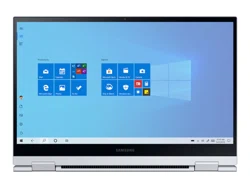Documents: Go to download!
User Manual
- User Manual - (English)
- Energy Guide - (English)
User Manual Computer
How to use
Turning the computer on and off
 Fully charge the battery using the AC adapter before using the computer for the first time.
Fully charge the battery using the AC adapter before using the computer for the first time.
Turning the computer on
1 Before turning on the computer, check that the battery is charged and charge it if necessary.
2 Open the LCD panel

3 The computer turns on automatically when the LCD panel is opened. If the computer does not turn on automatically, press the Power button.

Turning the computer off
1 Select the Start button 
2 Select 
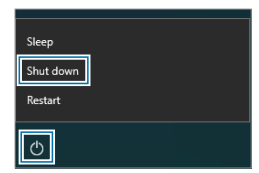

- Save all data before turning off the computer.
- Since the procedures to turn the computer off may differ depending on the installed operating system, turn the computer off according to the procedures for the purchased operating system.
Unlocking the screen
To unlock the lock screen, do one of the following:
- Touch screen: Swipe upwards from the bottom of the screen.
- Mouse: Click the lock screen. • Keyboard: Press any key.
- Touchpad: Tap the touchpad. If the account has a password, enter the password to log in after unlocking the screen
Configuring the Windows Settings
You can configure the basic system settings, such as installing or uninstalling apps and managing accounts, on the Windows Settings screen. Select the Start button 
Then, select an option you want to change after the Windows Settings screen appears.

Action Center
The Windows 10 action center allows you to receive system notifications, such as updates, and push notifications, such as emails and SNS updates. You can also adjust settings conveniently. For example, you can select wireless network options or adjust the volume and screen brightness via hot keys in the action center.
Checking notifications
1 Select  on the taskbar
on the taskbar
2 When the action center panel appears, select a message to check it
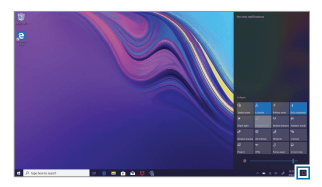
Using the computer as a tablet
You can use the computer as a tablet by folding the LCD panel behind the keyboard.
1 Open the LCD panel and rotate it away from the keyboard until it touches the bottom side of the computer.

 When the LCD panel is tilted past the transition point
When the LCD panel is tilted past the transition point
- The keyboard and touchpad will automatically be locked and will not function. But, during processes that start before Windows operation, such as the BIOS setup or DOS, the keyboard and touchpad will not be locked.
- The display will rotate automatically depending on the computer’s orientation.
 When storing the computer in a bag or carrying it, close the LCD panel to protect the computer.
When storing the computer in a bag or carrying it, close the LCD panel to protect the computer.
2 A mode switch confirmation message will appear when the LCD panel is tilted past the transition point. Select Yes to switch the computer’s display to tablet mode.
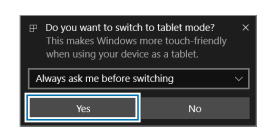
The display will switch to tablet mode
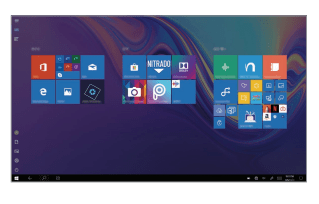

- When you rotate the LCD panel back to the normal position, a mode switch confirmation message will appear. Select Yes to switch the computer’s display to desktop mode.
- When the screen is turned off while using the computer as a tablet, touch the screen to unlock it. When the computer is in sleep mode, press the Power button to unlock the screen.
You can also switch the computer’s display to tablet mode without rotating the LCD panel.
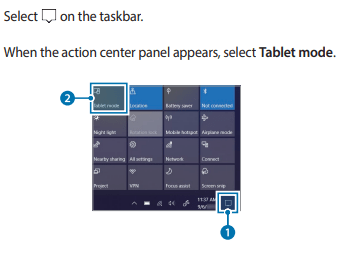
Touch screen
Use your fingers on the touch screen to perform actions.
Touch screen gestures
Tapping
To select menus, options, or applications, tap the touch screen.

Double-tapping
To open files or items, double-tap the touch screen.
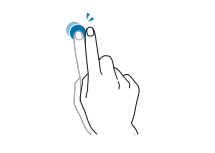
Tapping and holding (right-clicking)
To use additional options of an item, tap and hold it on the touch screen.

Dragging
To move an item to another location, tap and hold it, and then drag it on the touch screen to the desired location.

Scrolling
To scroll up, down, left, or right, swipe on the touch screen.
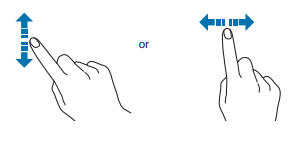
Spreading and pinching
To zoom in, spread two fingers apart on an image or text. Pinch to zoom out.

Keyboard
Enter text or access computer functions with the keyboard.

Using hot keys
To use keyboard hot keys, do one of the following:
- Press and hold the Fn key and press a hot key

- Press the Fn Lock key. When the Fn Lock key turns on, press a hot key
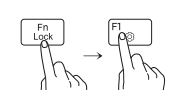
Hot key functions
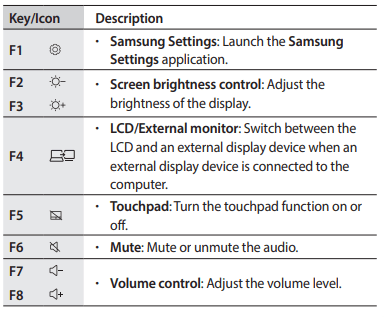

Touchpad
Use the touchpad to move the cursor or select an item. The left and right buttons of the touchpad act the same as the left and right buttons of a mouse
Basic touchpad functions
Moving
To move the cursor, move a finger on the touchpad

Clicking
Tap the touchpad or press the left touchpad button
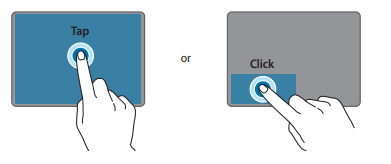
Double-clicking
Double-tap the touchpad or press the left touchpad button twice.
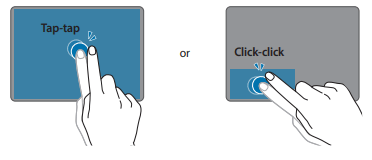
Right-clicking
This function enables right-clicking. To right-click an item, press the right touchpad button.

Dragging
To move an icon or an app tile to a desired location, press and hold it and then drag it to the target position with the left touchpad button pressed.
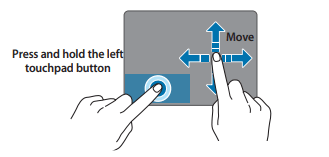
Gesture functions
Swiping
To scroll up, down, left or right to a desired location, swipe with two fingers on the touchpad.
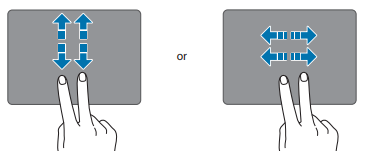
Pinching
To zoom in, spread two fingers apart while viewing a website, map, or image. Pinch to zoom out.

Application
Using applications

- Images and features may differ depending on the model and the application version.
- Some applications may not be supported depending on the model.
- Applications that are provided by Samsung can be installed from Samsung Update.
- Third-party software related services For descriptions about and service requests for third-party applications, please contact the relevant manufacturer. Some troubleshooting actions in response to service requests may not work depending on the application manufacturer.
Samsung Settings
Samsung Settings, a Samsung-integrated settings application, offers various settings functions.
1. Select the Start button 
2. Select an option to configure the corresponding function.
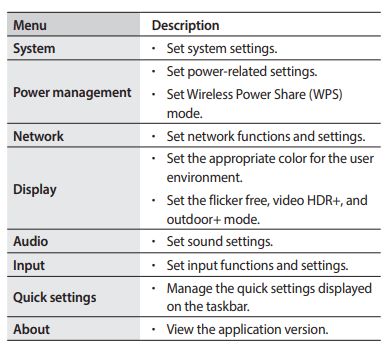
Samsung PC Cleaner
Samsung PC Cleaner helps your computer maintain its performance by using the timeline manager feature and the system cleaner feature.
Select the Start button 
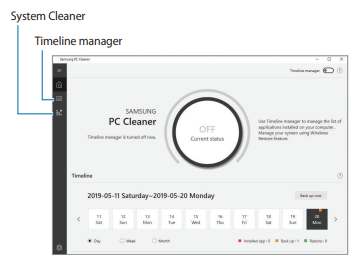
Timeline manager
Timeline manager tracks your application installation history and helps you manage computer performance by automatically managing your Windows backup points. You can manage the list of applications installed on your computer and your system using the Windows Restore feature.
System Cleaner
You can optimize the computer performance by cleaning up unnecessary system resources.
Quick Search
Search for content on the computer quickly.
1. Select the Start button  .
.
Alternatively, press and hold the Fn key and press the F12 key.
2. Tap  to select the types of content you want to search.
to select the types of content you want to search.
3. Tap the search field to enter a keyword.
Content on your computer will be searched.
If you choose a search category, you can get more exact results.
Setting & Upgrade
LCD brightness
Adjust the LCD brightness to reduce eye strain and save power.
Controlling brightness using the keyboard
- To dim the LCD screen, press and hold the Fn key and press the F2 key.
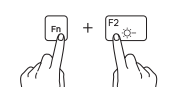
- To brighten the LCD screen, press and hold the Fn key and press the F3 key.

Controlling brightness using the taskbar
1. On the taskbar, select  .
.
2 Drag the adjustment bar to the desired brightness.
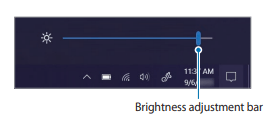
Changing display mode
Select the optimal screen settings based on your activity
1. Select the Start button  .
.
2. Select Display → QLED Auto mode, and then select an option.
- QLED Auto mode: Optimizes the screen automatically for the currently running program.
- Dynamic: Makes scenes more vivid and clear.
- Standard: Appropriate for normal environments and convenient for most situations.
- Reading: Appropriate for reading documents.
- Natural: Renders content more close to the actual color.
- Professional profile: Optimizes content for professional applications.
Optimizing the full screen color balance
Optimize the screen color by adjusting the color tones to your preference.
1. Select the Start button .
.
2. Select Display → Advanced color settings.
3. Drag the color adjustment bar to the desired color tone.
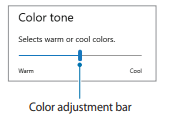
Volume
Controlling volume using the keyboard
- To turn down the volume, press and hold the Fn key and press the F7 key.

- To turn up the volume, press and hold the Fn key and press the F8 key.
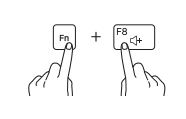
- To mute or unmute the volume, press and hold the Fn key and press the F6 key.

Controlling volume using the taskbar
1. Select  on the taskbar.
on the taskbar.
2. Drag the adjustment bar to the desired volume.
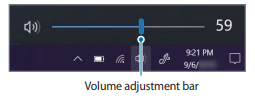
BIOS
Setting a boot password
1. Turn on the computer.
2. Before the Samsung logo appears, press the F2 key several times.
3. Access the Security menu.
4. Select a password type (Supervisor Password, User Password, or HDD Password).
If you cannot select an item or the HDD Password Frozen message appears, turn off the computer and turn it on again. Then, press the F2 key several times before the Samsung logo appears to enter the BIOS setup screen.
5. Enter a password and select Ok. The password can be up to 20 characters.
6. Enter the password again to confirm it and select Ok.
7. Select Save → Ok to save and restart.
Removing a password
1. Turn on the computer.
2. Before the Samsung logo appears, press the F2 key several times.
3. Access the Security menu.
4. Select a password type (Supervisor Password, User Password, or HDD Password).
5. Enter the current password and select Ok.
6. Without entering any characters, select Ok → Ok.
7. Select Save → Ok to save and restart.
Troubleshooting
Samsung Recovery
Recovering to factory default
You can restore the computer to its factory default settings. If necessary, back up important data to an external storage device before restoring the system. See Backing up data.
1 When the computer starts Windows:
Select the Start button  .
.
When the computer does not start Windows:
Turn on the computer and press the F4 key several times before the Samsung logo appears.
2 Select Computer factory reset → Start factory reset.
Follow the on-screen instructions to complete the recovery to its initial status.

Backing up data
Back up important data to an alternate internal drive or an external storage device regularly to prevent data loss.
Backing up the current system
You can back up the factory default system or current system to an alternate internal drive or an external storage device.
1 Select the Start button  → Samsung Recovery → Back up computer.
→ Samsung Recovery → Back up computer.
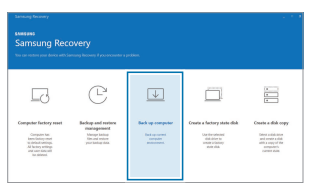
2 Select a drive to save the backed up data → Start backup.
- When backing up to an external storage device, connect the device to the computer and then select the external drive.
3 Follow the on-screen instructions to complete the backup.
Backing up user data
You can back up data files and folders.
1 Turn on the computer and press the F4 key several times.
2 Select Back up user data.
3 Select the files or folders to back up and choose a storage device to save the data to and then select Start backup.
- The backed up folders or files can be saved only on an external storage device. Connect an external storage device to your computer first and then select the external drive.
4 Follow the on-screen instructions to complete the backup.
Recovering after a backup
Select a backup point saved on an alternate internal drive or an external storage device to recover the computer to that point.
1 When backing up to an external storage device, connect the device to the computer.
2 Select the Start button  → Samsung Recovery
→ Samsung Recovery
3 Select Backup and restore management.
4 Select Restore of the data you want to recover → Start restore.
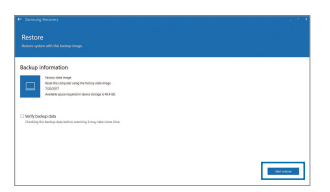
5 Follow the on-screen instructions to complete data recovery.
Copying the drive (making a disk image)
To replace the drive, move the data to the new drive by making a disk image. The new drive must be large enough to hold the data from the current drive. Purchase an external hard drive connector separately to connect the new drive to the computer
1 Connect the new drive to the computer with an external hard drive connector.
2 Select the Start button  → Samsung Recovery.
→ Samsung Recovery.
3 Select Create a factory state disk or Create a disk copy.
4 Select a disk to be copied → Start copy. The data on the disk is copied to the new disk
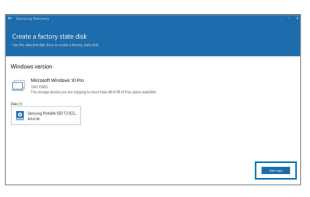
Window Recovery function
If the Samsung Recovery application is not supported by the computer, reinstall Windows using the recovery function of Windows.
 Reinstalling Windows will erase all data saved on the computer. Back up application and personal data to an external storage device before reinstalling Windows.
Reinstalling Windows will erase all data saved on the computer. Back up application and personal data to an external storage device before reinstalling Windows.
1 Select the Start button  → Update & Security → Recovery.
→ Update & Security → Recovery.
2 Select Reset this PC → Get started.
3 Select Keep my files or Remove everything.
 After the system is recovered, select the Start button
After the system is recovered, select the Start button 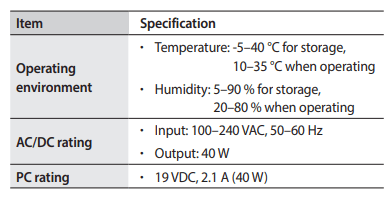
→ Samsung Update to install the required Samsung applications.
Q&A
When experiencing problems with the computer, try these solutions. Windows How can I uninstall an application?
1 Select the Start button  → Apps → Apps & features.
→ Apps → Apps & features.
2 On the list, select an app to delete and then select Uninstall.
What is a Recovery Area?
- The computer has an additional partition for restoring data or saving backup files (only for models with the Samsung Recovery application). This partition is called a Recovery Area and it includes a recovery image comprised of the operating system and applications.
Why is the capacity representation of the hard disk drive (HDD) in Windows different from the product specifications?
- The capacity of the storage device (HDD or SSD) of the manufacturer is calculated assuming that 1 KB = 1,000 Bytes. However, the operating system (Windows) calculates the storage device capacity assuming that 1 KB = 1,024 Bytes, and therefore the capacity representation of the HDD in Windows is smaller than the actual capacity. The capacity representation in Windows may be smaller than the actual capacity because some applications occupy a certain area of the HDD outside of Windows. For models with the Samsung Recovery application, the HDD capacity representation in Windows may be smaller than the actual capacity because the Samsung Recovery application uses a hidden area of 5–20 GB of the HDD to save the recovery image, and that hidden area is not counted towards the total size available to Windows. The size of the Samsung Recovery application varies by model.
What is a recovery image?
- This refers to the operating system, drivers, and software that are converted to a data image. It is required to recover the computer and is embedded in the computer’s HDD. However, this is not provided for storage devices where the capacity is less than 64 GB, due to their small capacities.
How can I restore a computer that does not have the Samsung Recovery application?
- Restore the computer with the recovery function provided by Windows. Refer to the Recover Functionality item in the help for more details.
The camera and the microphone are not working. How do I turn them on again?
- When recording protect mode is activated, the camera and microphone will not work. Select the Start button
 → Samsung Security → Block Recording and tap the switch to turn the features off.
→ Samsung Security → Block Recording and tap the switch to turn the features off.
The computer does not turn on automatically when the LCD panel is opened.
- To turn on the computer, the LCD panel should be opened greater than a certain angle. The angle may differ depending on the model. If the computer LED does not turn on automatically, press the Power button.
Product Specifications
The system specifications may differ depending on the derived model. For detailed system specifications, refer to the product catalog.
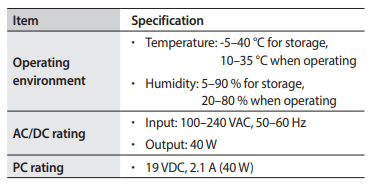

- Optional components may not be provided or different components may be provided depending on the model.
- The system specifications are subject to change without notice.
- The Storage device capacity of a computer in which Samsung Recovery is installed, is smaller than the product specification.
- For some models, it is not possible to add storage or add or replace memory due to the computer’s design. To replace the storage, contact the Samsung Service Center. You will be charged for this service.
- The amount of memory that Windows can use may be smaller than the actual amount of memory available.
See other models: SM-N970UZSACCT ME21H706MQS/AA SM-G970UZBETMB SM-N970UZIASPR LC24FG73FQNXZA
